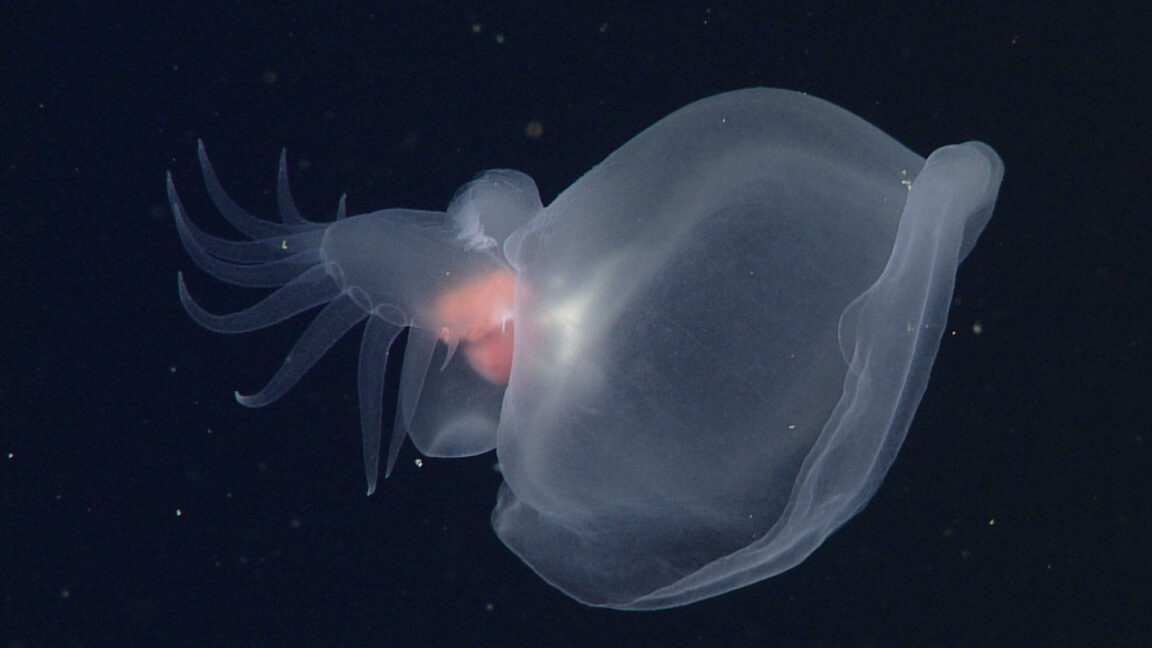
Researchers finally identify the oceans mystery mollusk
arstechnica.com
That's deep Researchers finally identify the oceans mystery mollusk It's a nudibranch, but so distantly related that it gets its own phylogenetic family. Elizabeth Rayne Dec 2, 2024 3:32 pm | 15 Credit: MBARI Credit: MBARI Story textSizeSmallStandardLargeWidth *StandardWideLinksStandardOrange* Subscribers only Learn moreSome of the most bizarre lifeforms on Earth lurk in the deeper realms of the ocean. There was so little known about one of these creatures that it took 20 years just to figure out what exactly it was. Things only got weirder from there.The organisms distinctive, glowing presence was observed by multiple deep-sea missions between 2000 to 2021 but was simply referred to as mystery mollusk. A team of Monterey Bay Aquarium Research Institute (MBARI) researchers has now reviewed extensive footage of past mystery mollusk sightings and used MBARIs remotely operated vehicles (ROVs) to observe it and collect samples. Theyve given it a name and have finally confirmed that it is a nudibranchthe first and only nudibranch known to live at such depths.Bathydevius caudactylus, as this nudibranch is now called, lives 1,0004,000 meters (3,30013,100 feet) deep in the oceans bathypelagic or midnight zone. It moves like a jellyfish, eats like a Venus flytrap, and is bioluminescent, and its genes are distinct enough for it to be classified asthe first member of a new phylogenetic family.Anatomy, diet, behavior, bioluminescence, and habitat distinguish this surprising nudibranch from all previously described species, and genetic evidence supports its placement in a new family, the MBARI research team said in a study recently published in Deep Sea Research.Is that a?Nudibranchs are gastropods, which literally translates to stomach foot since the foot they crawl around on when not swimming is right below their guts. They are part of a larger group that includes terrestrial and aquatic snails and slugs. B. caudactylus, however, seems to get around more like a jellyfish than a sea slug. It mostly swims using an oral hood that opens and closes to propel itself backward through the water in a manner similar to many jellyfish.The hood of B. caudactylus can also act something like a Venus flytrap. While it is not a hinged structure like the leaves of the plant, it is used to trap prey. Typically small crustaceans, the prey are then pushed to the mouth at the back of the hood. The mystery mollusk. The nudibranch also seems to have a unique way of avoiding becoming food itself. Projections at the end of its tail, known as dactyls, can detach if needed, much like the tails of some lizard species. The MBARI team thinks that these dactyls are possibly a lure meant to trick predators while the nudibranch swims away. They later regenerate.B. caudactylus is gelatinous and transparent, with a smooth heart, textured digestive gland, and whitish brain that can easily be seen from the outside. On its head are two antenna-like chemosensory organs known as rhinophores, which probably help it sense prey. A cylindrical foot helps with locomotion on the ocean floor. Like many other bioluminescent organisms in the deep sea, it glows blue, since red light does not transmit far at those depths.Almost alienSo how is B. caudactylus related to other nudibranchs? The researchers sequenced three of its genes and compared them to sequences from two prominent groups of nudibranchs (the dorids and cladobranchs) to find out. While the sequences of each B. caudactylus version of the gene had differences with those of the other groups, they still had enough in common for the mystery mollusk to be classified as a nudibranch.The three genes supported that Bathydevius is a divergent genus of Nudibranchia, the MBARI team said in the same study. [It is a] sister to the rest of cladobranch and dorid nudibranchs [and a] sister to [the genus] Bathydoris.Even with its genetic relationship to other nudibranchs, there are many areas where B. caudactylus deviates. It is not the only nudibranch with a hood that traps prey, and also not the only species to prey on crustaceans, which is rare for nudibranchs, which usually feed on cnidarians like jellyfish. It also lacks a radula, the tongue-like structure most nudibranchs eat with. Melibae leonina shares all these characteristics but it is genetically distant. The researchers think that the similarities between the two species are a result of convergent evolution, when genetically unrelated organisms develop similar characteristics.Bioluminescence is also uncommon in nudibranchs. B. caudactylus is only the third known bioluminescent nudibranch and seventh known bioluminescent gastropod. Again, its only distantly related to the other species.The deep ocean is the closest thing to an alien environment, yet its right on our own planet. Much of it either remains unexplored or is still not well understood. This could mean that there are still many undiscovered species hiding in the darkness. Protecting their ecosystems could give us a chance to find more forms of life just as strange and fascinating as a glowing sea slug.Deep Sea Research, 2024. DOI: 10.1016/j.dsr.2024.104414Elizabeth Rayne Elizabeth Rayne is a creature who writes. Her work has appeared on SYFY WIRE, Space.com, Live Science, Grunge, Den of Geek, and Forbidden Futures. She lurks right outside New York City with her parrot, Lestat. When not writing, she is either shapeshifting, drawing, or cosplaying as a character nobody has ever heard of. Follow her on Threads and Instagram @quothravenrayne. 15 Comments
0 Comments
·0 Shares
·103 Views


